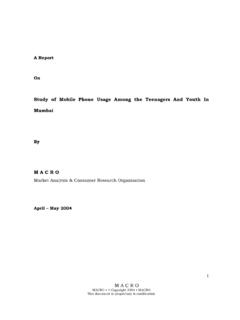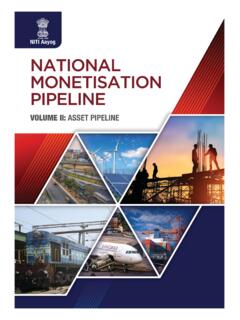Transcription of MARKET STUDY ON THE TELECOM SECTOR IN INDIA
1 Fair Competition For Greater Good MARKET STUDY ON THE TELECOM SECTOR IN INDIA . Key Findings and Observations Competition Commission of INDIA 10th Floor, Office Block - 1, Kidwai Nagar (East), New Delhi - 110023, INDIA CONTENTS. CHAPTER 1: INTRODUCTION .. 1. CHAPTER 2: INDUSTRY TRENDS ..2. CHAPTER 3: COMPETITION ISSUES ..14. CHAPTER 4: CONCLUSION AND SUMMARY OF OBSERVATIONS .25. Disclaimer This Report on the MARKET STUDY on the TELECOM SECTOR in INDIA and the information contained herein is for general purposes only and is based on broad trends and views that have emerged in the stakeholder consultations. The Report relies on surveys, stakeholder interactions, focused group discussions and written submissions made by stakeholders. It is assumed that the information provided during the course of the MARKET STUDY is complete, accurate, and not misleading. This exercise has been carried out as a part of the advocacy measures of the Commission to ensure competitive outcomes resultant to the MARKET STUDY .
2 The views expressed are not binding on the Commission for any legal purpose. Any comments/feedback should be addressed to Glossary AAEC Appreciable Adverse Effect on Competition AGR Adjusted Gross Revenue ARPU Average Revenue Per User BSNL Bharat Sanchar Nigam Limited BWA Broadband Wireless Access CAGR Compounded Annual Growth Rate CCA Combinatorial Clock Auction CCI Competition Commission of INDIA CDN Content Delivery Network COAI Cellular Operators Association of INDIA CPP Calling Party Pays DoT Department of TELECOM EBIT Earnings before Interest and Taxes FDI Foreign Direct Investment FNP Fixed Line Portability FTTH Fiber to the Home GDP Gross Domestic Product GDPR General Data Privacy Rules HHI Herfindahl-Hirschman Index ICR Interest Coverage Ratio ISP Internet Service Provider IUC Interconnection Usage Charge LTE Long Term Evolution MNP Mobile Number Portability MoU Minutes of Use MVNO Mobile Virtual Network Operator NDCP National Digital Communication Policy NTP National TELECOM Policy PAT Profit after Tax PDO Public Data
3 Offices PPP Purchasing Power Parity PRBT Personal Ring Back Tone OTT Over-the-Top QoS Quality of Service RAN Radio Access Network ROCE Return on Capital Employed ROE Return on Equity RoW Right of Way SEP Standard Essential Patents SMP Significant MARKET Power SMRA Simultaneous Multiple Round Ascending STV Special Tariff Voucher SUC Spectrum Usage Charges TMT Technology, Media and Telecommunications TRAI TELECOM Regulatory Authority of INDIA TSP TELECOM Service Provider UL Universal License UAS Unified Access Services VIL Vodafone-Idea Limited VNO Virtual Network Operators CHAPTER 1. INTRODUCTION. 1. In January 2020, the Competition Commission of INDIA ( the Commission'). launched a MARKET STUDY on the TELECOM SECTOR in INDIA ( the STUDY '). This STUDY is a fact-finding exercise, tracing the recent evolution of the industry, analysing threats and challenges to competition, identifying strengths and opportunities in the wake of technological innovations and recommends measures that will secure the growth of a dynamic TELECOM industry in the future.
4 2. The objective of the STUDY is to assess the level of concentration and competition in the TELECOM SECTOR , highlight changes in competition strategies, analyse the dynamics of competition and cooperation between TELECOM services and related industries such as over-the-top (OTT) services, tower companies and infrastructure providers, and finally, examine regulations and policy developments from a competition standpoint. 3. The STUDY employs mixed methods using both quantitative and qualitative techniques. Data was collected and analysed from published reports and other online resources to present industry trends such as revenue growth, MARKET concentration ratios, financial health and profitability of the TELECOM companies. 4. Interactions with stakeholders, including operators, equipment manufacturers, content companies, academics, SECTOR experts, business associations and government formed a core part of the analysis. An online survey was designed to capture changing consumer preferences for TELECOM services in INDIA .
5 This survey includes, among other things, questions on the choice of operator and technology, substitutability between access points and operators. 6. This Report1 summarises the main findings of the STUDY . The outcomes are based on secondary data analysis, survey responses, and feedback from one-on-one meetings and written submissions from stakeholders. A triangulation exercise was also carried out to ensure the integrity and consistency of data. 7. The report is structured as follows: Chapter two traces the recent history of the industry, highlighting trends and MARKET outcomes, Chapter three discusses the key competition issues facing the industry and those that are likely to emerge in the future. The observations and the way forward are summarised in Chapter 4. 1. Implementation Partner for the STUDY was the indian Council for Research on International Economic Relations (ICRIER). 1. CHAPTER 2. INDUSTRY TRENDS. A. MARKET Structure and Price-based Competition 8.
6 INDIA 's TELECOM SECTOR is not only one of the largest but also among the fastest- growing networks in the world. The increase in subscriptions has been nothing short of dramatic, on occasions touching 20 million in a month. In the first decade of the 21st century, subscribers grew at 33 per cent annually. Technological progress and an enabling policy regime combined to transform the MARKET , expand the network and produce a staggering growth. In 1999, when the New TELECOM Policy was announced, there were thirteen 2G technology-based private mobile service providers. By 2019, exits and consolidation had reduced the number of operators to eight. Today, TELECOM networks are the backbone of INDIA 's digital economy with 4G technology firmly in situ in all private networks. The country-wide lockdown due to COVID-19 unambiguously established the centrality of communications in maintaining economic activity and elevated its growth impacts. The SECTOR 's contribution to INDIA 's GDP is estimated to have increased by 5 to 6 times2 during this time.
7 Table 1: A Decadal View of the TELECOM Industry Parameter 1999 2009 2019. Number of Operators 15 21 8. HHI* by Subscribers (by AGR) 1198 1608 (1790) 2791 (2938). SMS, Voice, SMS, Calls, Internet, OTT, Primary Services SMS, Voice Internet (Tripleplay/Quadplay bundles). Mobile Technology 2G 2G, 3G 2G, 3G ,4G. ARPU 1319 205 MoU 197 484 691. Net Profit Margin for (2004) 21 Incumbent** (%). Source: ICRIER's calculation based on TRAI Performance Indicators Report. Notes: *The Herfindahl-Hirschman Index (HHI) measures MARKET concentration and is a metric used to determine MARKET competitiveness, often pre- and post- M&A transactions. It is calculated by squaring the MARKET share of each firm competing in a MARKET and then summing the resulting numbers. The EC Screening thresholds for horizontal mergers considers a MARKET with an HHI < 1000 as unconcentrated MARKET and HHI > 2000 as highly concentrated MARKET . It is also unlikely to identify horizontal competition concerns in a merger with a post-merger HHI between 1000 - 2000 and a delta below 250, or a merger with a post-merger HHI above 2000 and a delta below 150.
8 ** It is the net profit by sale for Bharti Airtel. 2. Data from techARC. takeaways-report/#tab-reviews 2. Figure 1: A Decadal View of the TELECOM Industry MARKET Entry and Exits Source: Compiled by ICRIER. 9. In September 2016, the MARKET witnessed the disruptive entry of Reliance Jio in voice and data services using 4G technology. Data prices saw an immediate decline from Rs. 180 per GB in September 2016 to Rs. 160 per GB in December 3. 2016 and a secular decline to Rs. per GB in While growth has been robust, price competition has squeezed the bottom line for incumbent operators. To lower costs and improve survival, smaller players were acquired, while big operators like Vodafone and Idea merged. The prevailing MARKET structure validates the empirical finding expressed as the rule of three,4 which predicts that mature markets normally support three main competitors, others who survive, are limited to the fringes or a niche. The three major private SECTOR operators, namely Jio, Airtel and Vodafone-Idea own almost per cent of the MARKET .
9 As of April 2020, Reliance Jio has the highest MARKET share with respect to subscribers ( per cent). Reliance Jio also held the highest share with respect to adjusted gross revenue ( per cent), as of March 2020. 10. As industry prices, measured by average revenue per user (ARPU) fell, consumption of both voice minutes and GBs of data increased. The growth rates for data were substantially higher, reflecting the low base. While Minutes of Use (MoU) increased at a CAGR of 12 per cent between 2014 and 2019, data usage per subscriber per month increased at a CAGR of 76 per cent during the same time. Figure : Evolution of Data Figure : Evolution of ARPU. Usage and Minutes of Usage and Data Prices 12 800 300. Data Usage per Subscriber per month ARPU and Average Price per GB Mobile 10. 600 250. Minutes of Usage 8. 200. 6 400. Data (in Rs). (in GB). 4 150. 200. 2 100. 0 0. 50. 0. Data Usage per subscriber per month 2014 2015 2016 2017 2018 Mar-19 Sep-19. Minutes of Usage per GSM mobile user ARPU Average Price per GB of Mobile Data Source: ICRIER's calculation based on TRAI Performance Indicators Report.
10 3. TRAI Performance Indicators Report. 4. Sheth, J. and Sisodia, R. (2002). The Rule of Three: Surviving and Thriving in Competitive Markets. New York: Free Press. 4. 11. Data centricity naturally changed the composition of ARPU, with data revenue capturing a higher proportion of the total revenue. Share of data in ARPU. increased from per cent in 2014 to per cent in 2019. Revenue from data increased at a CAGR of 27 per cent between 2014 and 2019 while that from voice and SMS declined at a CAGR of 26 per cent and 21 per cent, respectively. Figure : ARPU Composition over Time 2019. Composotion of ARPU per month 2018. wireless services (%). 2017. 2016. 2015. 2014. 0% 10% 20% 30% 40% 50% 60% 70% 80% 90% 100%. Rental Revenue Revenue from Calls Revenue from SMS Revenue from Data Usage Reveneue from VAS Other Revenue Revenue from Outroamers Source: TRAI Performance Indicators Report. Note: Other revenue includes interconnect usage charges and roaming settlement charges.








